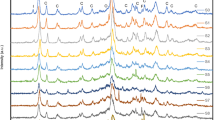Abstract
Acidity and basicity of alumina-boria catalysts supported on porous or non-porous alumina have been studied by adsorption microcalorimetry of probe molecules (ammonia, pyridine and sulphur dioxide). Despite decreasing in initial heats, the total acidity as determined by ammonia adsorption increased in number and strength as a function of percentage of boron oxide. Ammonia, as a strong base, was shown to cover all types sites from strong to weak acid sites. Pyridine, as a weaker probe, was shown to dose only the stronger sites of the samples which stay nearly constant after B2O3 coverage approaching the monolayer. The basic sites of the amphoteric alumina support are neutralized by 10 wt% of boron oxide on non-porous alumina and 20 wt% of B2O3 on porous alumina. The catalytic activity for partial oxidation of ethane increased with acidity and reached a maximum constant value above 20 wt% of boron oxide.
Zusammenfassung
Mittels Adsorptions-Mikrokalorimetrie von Probemolekülen (Ammoniak, Pyridin und Schwefeldioxid) wurde die Azidität und die Basizität von Aluminiumoxid-Boroxid-Katalysatoren auf porösem oder nichtporösem Aluminiumoxid-Trägermaterial untersucht. Trotz Abnahme der Anfangswärme nimmt die mittels Ammoniakadsorption ermittelte Gesamtazidität zahlenmäßig und der Stärke nach als eine Funktion des prozentuellen Gehaltes an Boroxid zu. Ammoniak deckt als starke Base alle Arten von Stellen (stark und schwach saure) ab. Das schwächere Probemolekül Pyridin deckt nur die stärkeren Probenstellen ab. Die basischen Stellen des amphoteren Trägermateriales Aluminiumoxid werden durch 10 Gew% Boroxid auf nichtporösem und durch 20 Gew% B2O3 auf porösem Aluminiumoxid neutralisiert. Die katalytische Aktivität für die partielle Oxidation von Ethan steigt mit der Azidität und erreicht bei 20 Gew% Boroxid einen konstanten Höchstwert.
Similar content being viewed by others
References
A. Auroux and A. Gervasini, J. Phys. Chem., 94 (1990) 6371.
J. Le Bars, J. C. Vedrine, A. Auroux, B. Pommier and G. M. Pajonk, J. Phys. Chem., 96 (1992) 2117.
A. Auroux and J. C. Vedrine, In Catalysis by acids and base; Imelik, B.,et al., Eds.; Studies in Surface Science and Catalysis 20; Elsevier, Amsterdam 1985, p. 311.
Y. Murakami, K. Otsuka, Y. Wada and A. Morikawa, Chem. Lett., (1989) 535.
Y. Murakami, K. Otsuka, Y. Wada and A. Morikawa, Bull. Chem. Soc. Jpn., 63 (1990) 340.
P. H. Emmett and S. Brunauer, J. Am. Chem. Soc., 59 (1937) 1553.
S. W. Nam and G. R. Gavaleas, Appl. Catal, 55 (1989) 193.
G. Cucinieri Colorio, B. Bonnetot and A. Auroux, J. Thermal Anal., 38 (1992) 2565.
Author information
Authors and Affiliations
Rights and permissions
About this article
Cite this article
Cucinieri Colorio, G., Auroux, A. & Bonnetot, B. Acidity and surface behaviour of alumina-boria catalysts studied by adsorption microcalorimetry of probe molecules. Journal of Thermal Analysis 40, 1267–1276 (1993). https://doi.org/10.1007/BF02546890
Published:
Issue Date:
DOI: https://doi.org/10.1007/BF02546890




